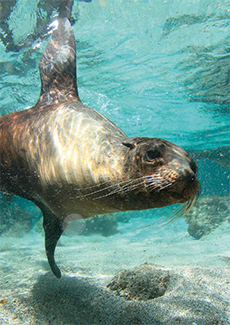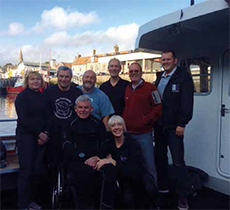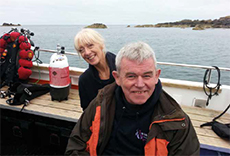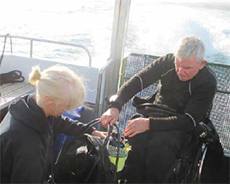




| Home | Features | Club Nights | Underwater Pics | Feedback | Non-Celebrity Diver | Events | 18 July 2025 |
| Blog | Archive | Medical FAQs | Competitions | Travel Offers | The Crew | Contact Us | MDC | LDC |

|

|
 
 |
    ISSUE 23 ARCHIVE - SCUBA TRUST HEAD TO EYEMOUTHHoward Sobey'OK then, let's give it a go!' said Lindsay. I was stunned into silence for a second or two. 'OK I'll arrange it!' I said.That was it! Decision made. Lindsay wanted to do some U.K. diving and see some seals and it was our responsibility to make it happen. This does not seem like a big challenge on the face of it, but what I haven't told you is that Lindsay is a paraplegic and he lost the movement in his lower body in 1976 as a result of a tractor accident. We were selling raffle tickets on the Scuba Trust stall at the Dive Show at the NEC at the time and I had gone off on one of my wistful rants about how diving should not be limited to a few weeks in the sun every year as there is so much around our shores that only takes a couple of hours in the car to get to. I am normally met with comments of 'too cold' or 'no viz' and eyed suspiciously as a BSAC revolutionary by some of the other members of the trust. I should explain that Scuba Trust is a non profit charity formed to promote scuba diving for all. Our helpers and instructors are all volunteers and come from a mixed background of BSAC, PADI and SSI and some instructors are trained to gain DDI (Disabled Divers International) and Deptherapy instructor qualifications. This enables us to teach people with disabilities beyond the normal scope of BSAC or PADI if required. The trust normally runs two foreign holidays a year. This year there was going to be three, Grenada, Marsa Alam (both very successful trips but those are stories for another time) and of course the U.K. So, where to go? I decided against Seahouses and visiting the seals of the Farnes, as the height of the harbour wall and the slippery steps up when the tide was out could have been troublesome for our divers. That was when Amanda came to the rescue and suggested Eyemouth. So we wandered, or wheeled, ourselves over to the other side of LIDS and spoke to Gary Steenvoorden at the Divestay stand about planning a possible trip. The harbour had a floating pontoon which was accessible with a wheelchair at any tide and the boats were big catamarans with a big kitting up deck suitable for a wheelchair and dive lift for easy access in and out of the water. Gary runs his own B&B in the centre of Eyemouth but he advised us to stay at the Eye Sleepover motel which had adapted disabled rooms available. Lindsay and his wife Sue had joined the Scuba Trust three years earlier and were experienced divers already. However it had been a few years since they had donned their dry suits and even then it had been in the relatively calm waters of Stoney Cove. After the first dive Lindsay said his position in the water was wrong and he felt that he was leaning backwards all the time. He tends to dive in an upright position with his legs trailing under him. He uses his hands with special webbed gloves to move in the water and as he's six foot six tall, his legs can create quite a lot of counterbalance. An able bodied diver learning to use a dry suit experiences some degree of uncertainty as the balance point of buoyancy shifts within the dry suit. In this case it had pitched Lindsay slightly backwards and meant that swimming through the water was made difficult and tiring. The solution was to hang two weights from the D rings on his shoulder straps of his BCD. This pitched him forward and made swimming a lot easier. Weighting is one of the most important aspects of learning to dive, even more so if you are disabled. A hanging weight, or pendulum, can sometimes be used to help the diver maintain a good position in the water. It can seem like the pendulum can pull the diver back into the preferred position better than a fixed weight does. We arrived on the Monday night. Lindsay and Sue had come up from East Anglia. Amanda (dive leader) had travelled from South London and Eric (advanced diver, OWI, Deptherapy instructor) and Paul (advanced diver, OWI) had travelled from Southampton. Ian (advanced diver, OWI, DDI, Deptherapy instructor) and I (dive leader, OWI, Deptherapy Instructor) had taken two days to travel up from Woking (via two dives at Stoney where I flooded my camera and a sightseeing tour of Bamburgh castle and Lindisfarne Island.) We checked in and went and had a fish and chip supper. All except for Lindsay who remembered his Scottish roots and ordered white puddin'. Day One:We were greeted by Billy the skipper who swung the boat round and Lindsay wheeled himself aboard via the double width dive lift at the back of the boat. Our first dive was the peanut wreck. Ian (probably the most experienced diver in our group) buddied with Lindsay and they had Amanda and Gary of Divestay as a back up behind them. All went well until about twelve minutes into the dive. They were in about 15m of water and had reached the boilers. Gary handed Lindsay a torch to look inside the boilers. This caused two things to happen. As Lindsay's head went down his feet went up and air inside the dry suit migrated. At the same time his ability to right himself was hampered by having a blooming great torch in his hand. It was not exactly clear what had gone wrong at the time but Lindsay exhausted himself trying to gain some control and so Ian ensured that there was a steady controlled ascent and the dive ended there. Lindsay had had a slight leak in his suit. Although the water was 12 degrees which is quite toasty for U.K. diving, a paraplegic who has no use of the bottom half of his body, does not create heat within his muscles and is therefore more susceptible to the cold. This coupled with the exertion of the first dive caused Lindsay to wisely decide to sit out the second dive. Day TwoAfter a lovely breakfast at The Home Arms (Gary's B&B) we were back on the boat heading out to the dive site. We had decided that Ian and I would take Lindsay in together, one in front to lead and one behind to steady any 'floaty feet' episodes. This dive went well. We spent 41 minutes at a maximum of 16m seeing lobsters, squat lobsters, velvet swimming crabs, and butterfish. Gary put up his smb and we started our 3 minute safety stop. I was hovering just behind Lindsay and I was aware that he was rising slowly and did not appear to be correcting it. I put my hand on his pillar valve at the top of his cylinder to steady him. Later on we were able to dissect what had occurred. He was unaware that I had a hold of him and wondered why he was feeling like he was going down slightly so he pumped more air into his BCD. Lindsay's BCD has the inflator controls on the pocket so he does not have to raise his arm when dumping air from his jacket, so I could not see that he was adding more air. Lindsay has no problem controlling his buoyancy in warm water but this time he also had his dry suit to contend with as well. We were still going up so I dumped most of my air. At the same time Lindsay realised what was happening and dumps some of his air as well so we ended up see-sawing up and down a bit before we sorted ourselves out. Fortunately Ian and Amanda had followed us up and down, ready to help if needed. It had been a lovely dive but we all decided to abort the second dive just to be on the safe side, as our dive profile would not have been the best! So we all had an afternoon in Dunbar watching the guillemots diving into the sea for herring. Day Three:After a hearty breakfast we were ready to go. We had discussed the previous days diving and had formulated the plan that on ascent one of us should send up a DSMB directly in front of Lindsay. He could then use that as a point of reference. At any time he could hold on to the line, make himself very slightly negatively buoyant and just hang there. We would go at his pace and should anything go wrong, and we needed to take over, we would give an agreed signal and he would leave it up to us. We started off with Ian behind Lindsay. I was in front of Lindsay pointing out all the life with my torch. I was swimming backwards most of the dive watching Lindsay and looking for things darting under rocks. I pointed out the red scorpion fish, the butter fish, lobsters and squat lobsters but I completely missed the ballet class given by two curious seals that swooped and circled around us. Lindsay, I am glad to say, did not miss any of it. All too quickly 50 minutes of dive time had elapsed and it was time to go up. The ascent plan was executed and it went perfectly. Back on board Lindsay was visibly moved by his experience. He and Sue had bought new gear, got their cylinders tested and had invested a lot of time and money in this trip. Sue told me later that as soon as she had seen Lindsay's face she knew it had all been worthwhile. Day Four:The first dive was at Anemone Alley. This is a small passage between two rock faces covered with anenomes. It was a beautiful dive. Lindsay said he was amazed at the colours, he never dreamed there would be so much in UK waters, imagining that it would just be green and drab. He said that after day three and four he felt so much better about his dry suit diving. After the experiments with weighting and buoyancy of days one and two, when he really wondered why he was doing it at all, he found his progress was very encouraging and that he really wanted to do it again. There were so many Lobsters we had to politely ask them to move aside as they were obscuring the rest of the wildlife. Personally, I was determined to see a wolf fish. Oh well! There is always next year. Scuba Trust are a charity dedicated to helping those with disabilities to be able to dive. The main focus of the charity is to be able to take the team on dive trips abroad and in the UK so that everyone can experience the true joy and relief of weightlessness whilst diving. The money that Scuba Trust raises throughout the year only covers the cost of members training in the UK, every person who attends one of the Scuba Trust's trips, including the instructors, pays for themselves. To find out how you can support Scuba Trust, visit their website. Previous article « Neemo XXI Next article » Coral Cay Conservation in the Philippines Back to Issue 23 Index |